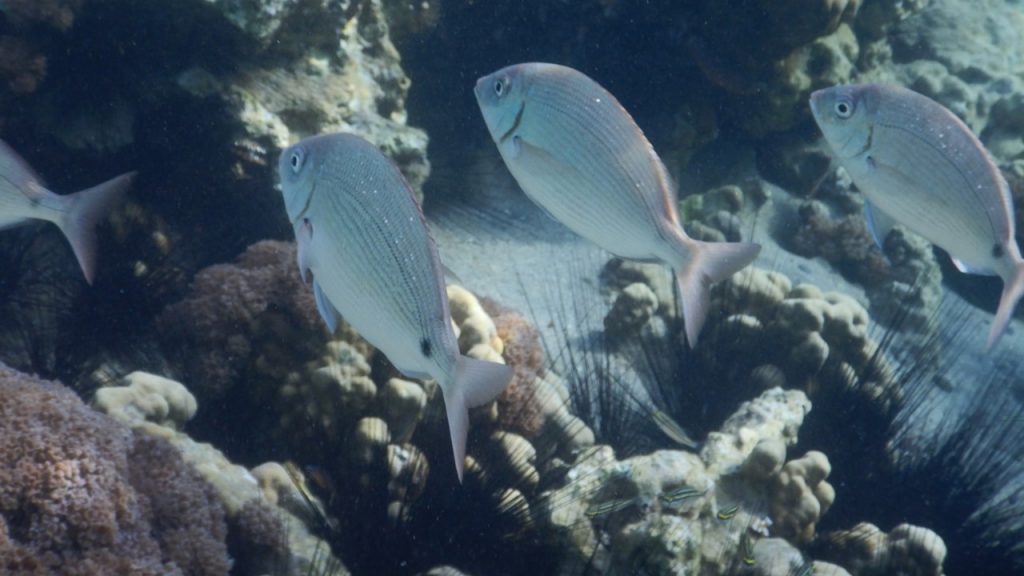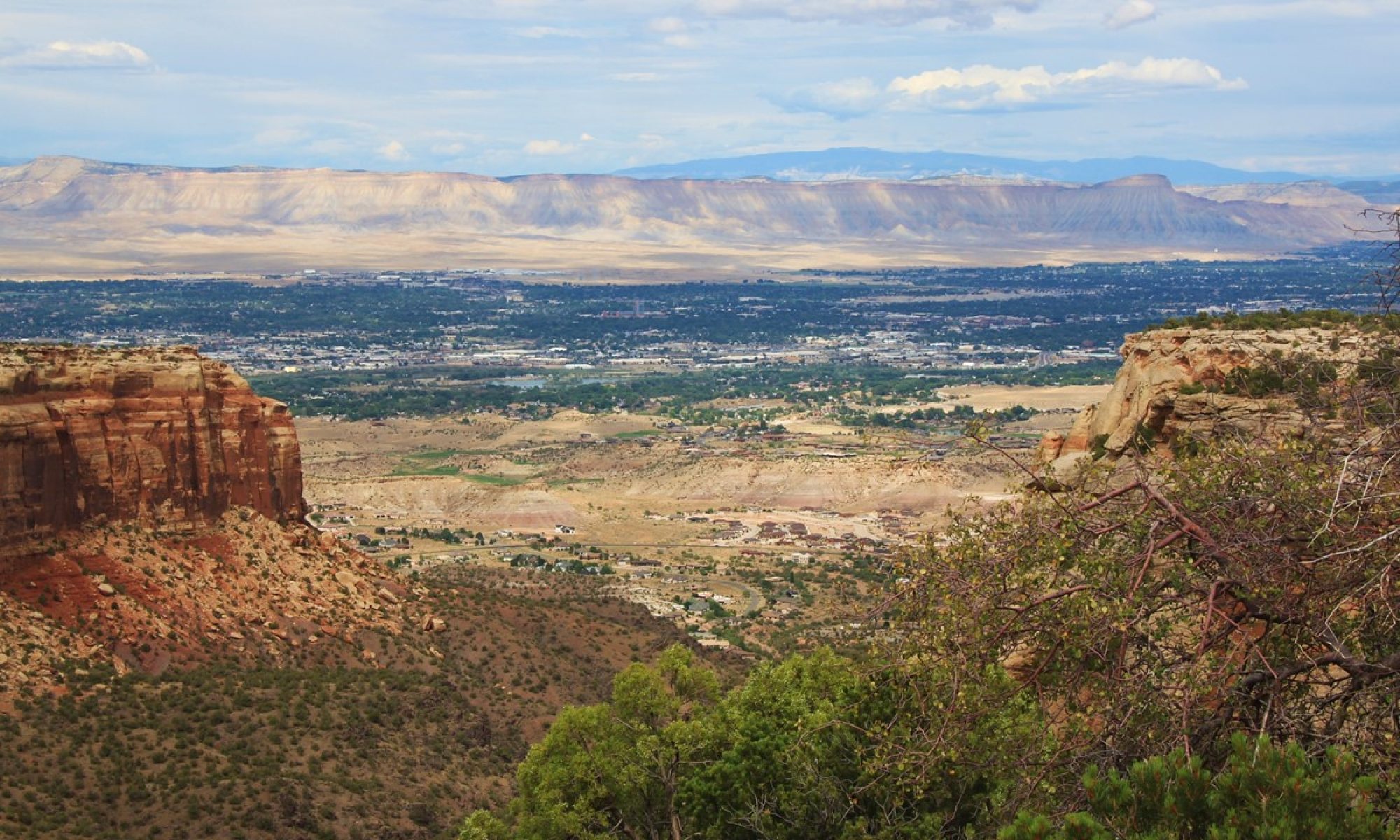Jordan
Amman
In November of 2022, we found ourselves with a unique opportunity to make an excursion on a brand new ship’s maiden voyage from Jordan to Dubai. Since many of our family had other Thanksgiving holiday plans, and neither of us had ever visited Petra in Jordan, and Julie had a strong desire to visit and shop in Dubai, the trip seemed ideal for us. Therefore, on November 17th, 2022 we flew from Washington, D.C. to Amman, Jordan where we met by our guide who cleared Immigration Control for us and transported us the 45-minutes to the Four Seasons Hotel where we had a spectacular view over the city on the 14th floor.
The city of Amman hosts over 40% of the country’s population, (~4 million out of 10 million people) as most of the country is desert and it is only the size of South Carolina. The area surrounding Amman has a good underground aquifer that supplies water for growing corn, strawberries, and other agriculture crops. Most of the food is grown in the winter when the weather is at its best. Amman is 3000 ft above sea level and is located ~40 minutes away from the Dead Sea which is at 1300 ft below sea level.
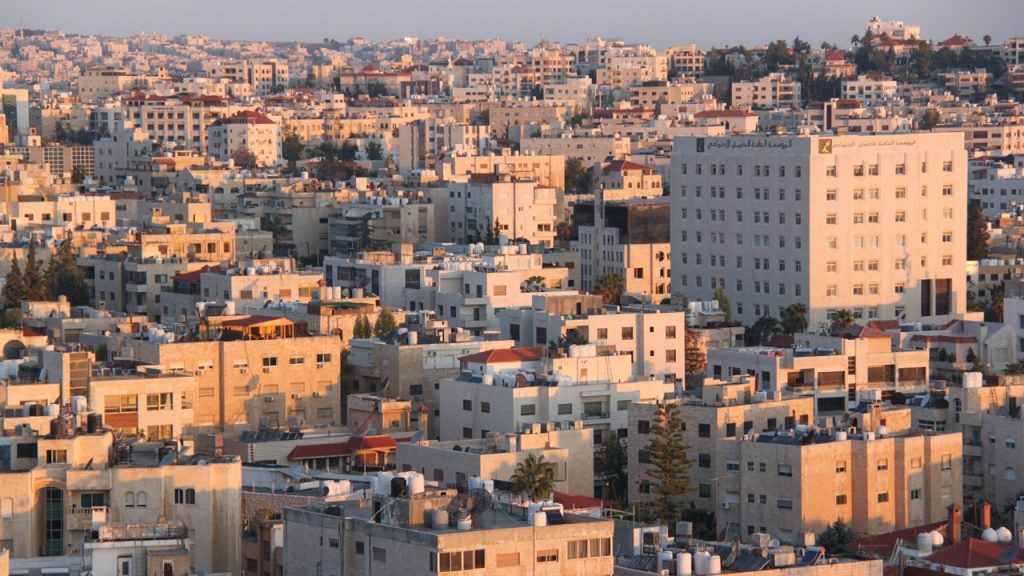
That afternoon, we took it easy, checked out the hotel’s amenities, and dined on a dinner of salads, veggies, beef, lamb and chicken dishes with an assortment of beautiful pastry desserts.
The next morning, after breakfast, we assembled for an orientation talk with our guide, an Egyptian Historian named Maged (pronounced “Mage – ed”), and learned about the history of the region. We did paperwork and divided into 3 smaller groups (~25-30 each) to be ready to board buses to travel into the city center to explore and have lunch. Our bus was led by a local guide, Hazim, who was a bit of a comedian, but with a degree in Physics!
At 11:30am, we boarded buses and traveled to our restaurant, The Tahaween Al Hawa, for lunch which consisted of an array of traditional dishes that included starters of puffed bread, salads, hummus, and vegetables. Then the main dishes of grilled beef, grilled chicken and grilled sausages were brought out, followed by fruit and sweets. It was difficult to maintain the resolve to not fill-up on any of the delicious early dishes, and the amount of food exceeded any hope our table had of finishing it.
After lunch, we traveled a short distance to the Castle of Amman located atop a hill that overlooked the city’s center to learn about its history. Nearby were open air ruins and a small museum about mankind’s early history in the area. The name “Amman” derives from the word “aman” for “white”, and was referenced to the fact that the city was built with white limestone. The people of Amman live on a typical Mediterranean diet of vegetables, olive oil, and chicken. Most locals eat a large lunch at 4:00pm and then a light, late dinner at around 8-9pm, and this suits the climate and the Islamic religion that dominates the region. Twenty percent of Jordan’s population is made up of refugees, mostly from Egypt and Syria. The old town Citadel (part of the Castle) contains the remains of many different historic cultures. This museum was Jordan’s first and had collected items from all over Jorden, even examples of the Dead Sea scrolls, (which have since been turned over to Israel.) The first structure was a 300 BC temple located at the top of Citadel which was built by the Romans. Then, the Byzantines ruled, followed by the Greeks with their biblical history and the building of churches throughout the region. Between the 4th and 7th centuries, over 4000 churches were built because of the freedom to worship that existed then. However, in the 8th century when Muslims came to rule the greater region, Jordan became the place where all refugees of any religion, and, from many other places came to live. Today, 90% of the population of Jordan are Muslim and 10% are Christian. We bused back down the hill and walked through the local open market, full of souvenir shops, clothes, and household items. We then toured an ancient Roman amphitheater built in the 2nd century. Finally, we ended up at a local Gold Market where gold is mostly sold for jewelry and dowries, (dowries are given by the groom and are typically $5000 and up.) After some free shopping time, we boarded the bus and headed back to the hotel were we cleaned-up and relaxed before assembling for a 6:00pm lecture followed by dinner and a bottle of wine.
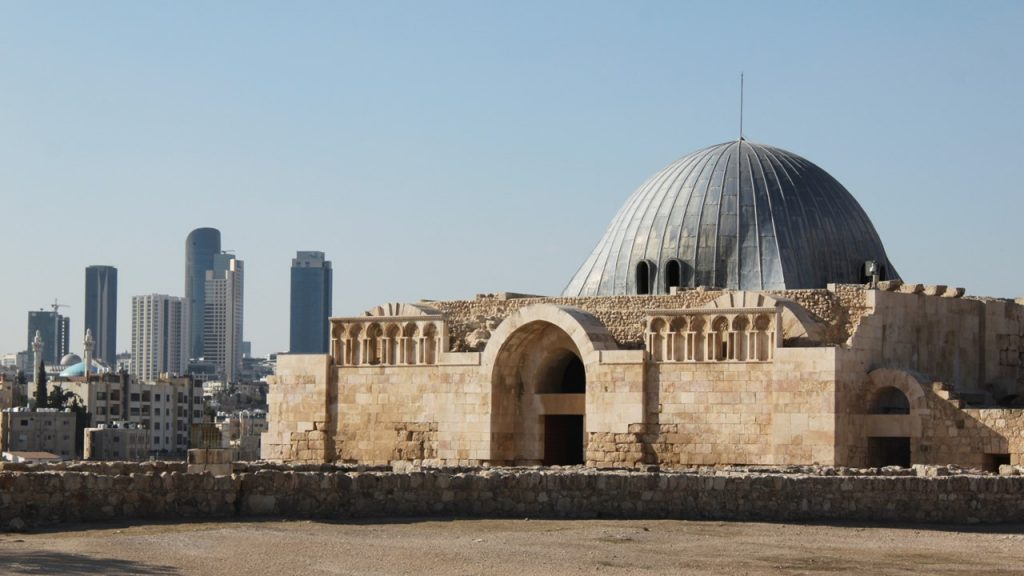

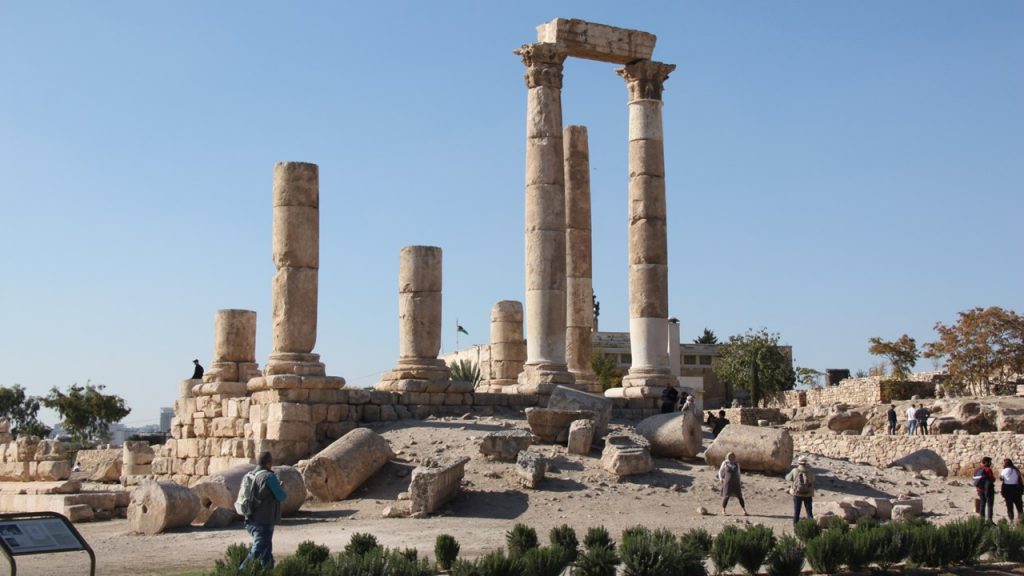
Bedouins
At the lecture, we learned about the people and their lives in Jordan. Jordan still has a significant number of Bedouin, but their numbers are decreasing. “Bedouin” in Arabic means “desert dwellers”. They typically follow the water or grass with their animals – either sheep & goats, or camels. Whatever they can raise or produce from their animals, they sell to survive . They live in tents made from goat hair that allows for warmth in the winter and air flow during the summer. In the tents, the women live on left side where the kitchen is located, and the men live on the right side. The women do most of the domestic work and the men are responsible for the animals. Most Bedouin wear head coverings to reduce heat and most women wear loose-fitting black in the desert because it does not allow UV light through and this keeps the air cooler inside. The only time one would see colors would be for a special occasion. Jordanians love coffee and have a tradition about drinking 3 cups:
First cup to drink because your throat is dry.
Second cup to savor the taste.
Third cup to get ready to fight, if necessary.
Most of the coffee in Jordan comes from Yemen. When the British were there, they brought tea. When coffee or tea is served, it is always served by the father of the household, and always with the right hand. When one finished the drink a shake of the cup indicates that you finished. After the coffee is finished, the Bedouin dig a hole outside their tent to bury the coffee grounds. They eat lightly and only eat meat occasionally. Their most common dish is “Mensa: – made with rice, meat, and milk or rice, meat, and yogurt, and sometimes nuts. They cook a thin bread on top of metal dome over fire, or make naan (a thick bread) in the oven.
Camels can travel 25 miles a day carrying 1,000 lbs, but most desert travel is at night. Women have the role of being the head of household, and they make the tent from hides, and they make the cushions, the food, etc. Men train the children how to fight, how to find water, and how to tend and protect the animals. In Jordan today there are only 40,000 Bedouins left as most young people are going to school and college, as they want an iPhone and a house. Today, 95% of Bedouins are still in farming & wandering the desert, and only 5% have settled into a single place, to have a car, and to shop in the city. Bedouin families very tight-knit and look after other family members. A camel is worth $2,000 for a male and $3,000 for a female. However, a good racing camel can fetch over a million U.S. dollars! The Jordanian government is pressuring the Bedouins to settle so that they can be taxed. The typical life expectancy of men is 74 years and for women is 72 years. In Jordan, the same rules and laws apply equally to men and women and it is considered one of he more liberal and progressive Islamic countries.
Petra
Sunday morning we arose early, had breakfast at the hotel, checked-out and left on a set of buses for the trip along Highway 15 through the desert to Petra. Along the way we learned a little bit more about the country of Jordan. The previous King, King Hussein had 4 wives with Queen Noor (an American) being the last one. She was a strong proponent for women’s education and job opportunities, and for equal pay. She also was a great patron of Jordanian mosaic crafts. When King Hussein came to the Mayo Clinic in the USA to be treated, his brother temporarily took over as King of Jordan. However, when King Hussein returned, he named his son Abdullah II the new king. Abdullah II has been king for 23 years and is now ~60 years old. Currently he has named his son, Prince Hussein, as the Crown Prince in line for the throne. Currently, Queen Noor lives in the US.
Jordanian schools are free and quite good for grades 1-12. However, university education must be paid for. Most of Jordan is desert with very few trees, and except for the Bedouins, most people live in a few cities – principally in Amman. Inside the city, a 3-bedroom apartment would cost ~$70,000, but outside of the city, it would cost ~$500,000. Many of the country’s major industries are foreign owned with phosphate mining owned by Brunei, water and airports owned by the French, and UAE owning the ports. Citizen taxes are typically charges on any income over $14,000, but there is social security payments for men over 60 and women over 55 years of age. There is 3-month Maternity Leave with full pay for all women. Today, there are no longer arranged marriages, but there is matchmaking where a gentleman, his friends and/or family go to meet in a “coffee ceremony” with a girl’s friends and family. Impressing the other’s social circle is an important first step. Then there is a marriage contract, religious requirements, and dowries to arrange. If they divorce, there must be financial compensation and any children always stay with the mother. The current divorce rate in Jordan is 12%. The marriage ceremony is planned by family and typically includes ~2500 people attending – the cost burden of which is all on the groom. The average number children in a family is 3 today where it had been 4 in the early 2000’s – in the 1990’s it was 7.
Approaching Petra, we turn onto “Queens Way”, and the sand changes color to a darker shade due to the increase in volcanic rock and hills. The area is populated with huge solar panel fields and windmill farms on both sides of the road. We climb in altitude to over 5500 feet and travel through a pass that is buried in snow in the winter. Up here, the temperature moderates and there are green trees and family gardens Finally, we head down the mountain-side to the ancient city of Petra. We arrived at Petra at ~11:30 am and have a lunch buffet of salads, beef, chicken and fish with desserts before setting off to explore at our own pace.
The walk into Petra is about 1+ mile through a breathtaking slot-canyon to the famous Treasury Building with its assortment of donkey-cart and camel rides available. Then we continue along further to the other side of the canyon walk and exit onto a Colonnade pathway leading to the Grand Temple. All along the way, the sides of the valley are carved with magnificent temple fronts and the sides are peppered with hollowed out caves that once served as accommodations for ancient Petra visitors. We then turned around and headed back to entrance, shopping at local vendors along the way. When we returned to the main entrance, we stopped for a cold local beer (Carakale) at the local bar/restaurant and waited for the return of the rest of our party. We left Petra at 4pm to headed to the Port of Aqaba where we would meet our ship.
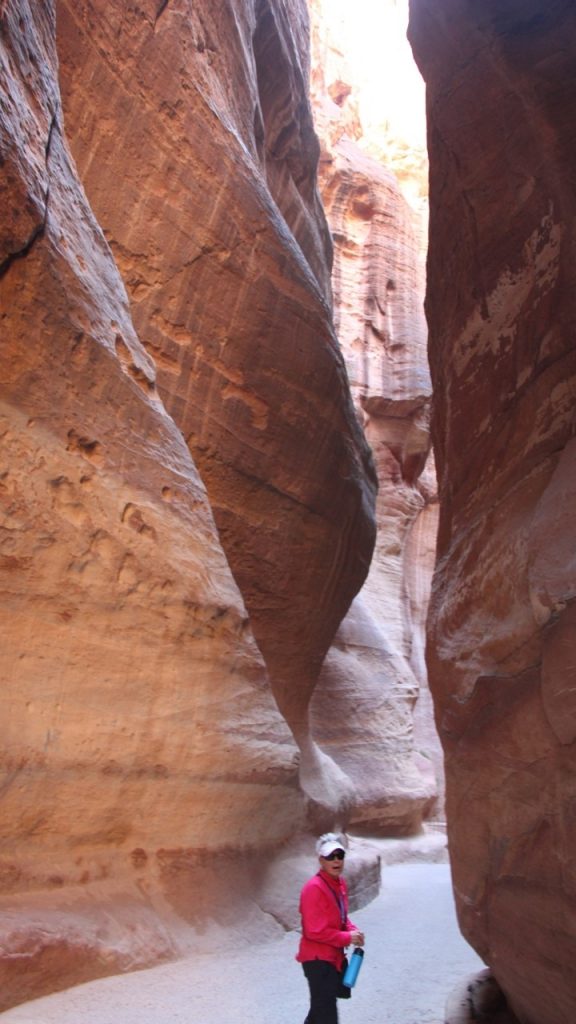
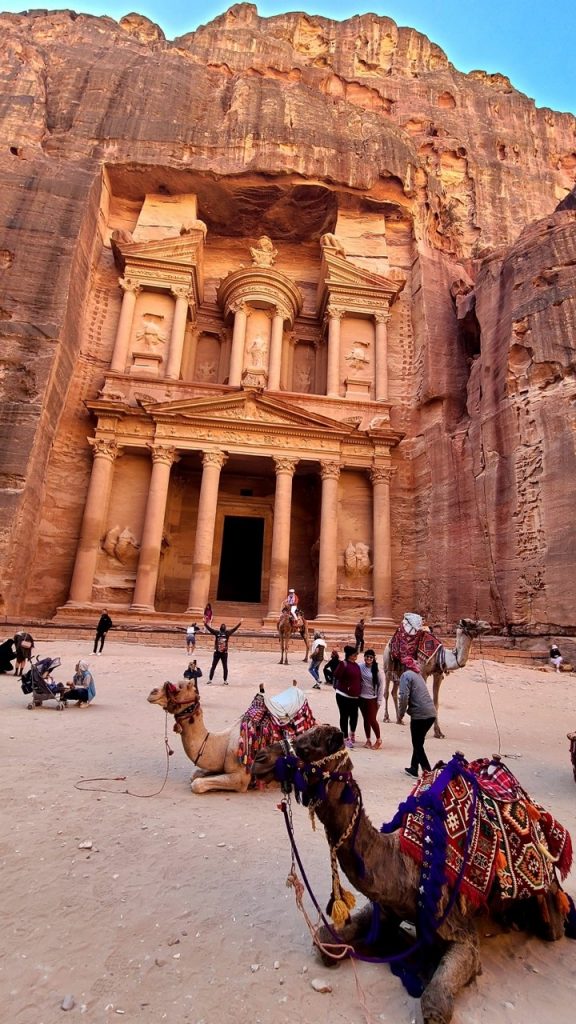
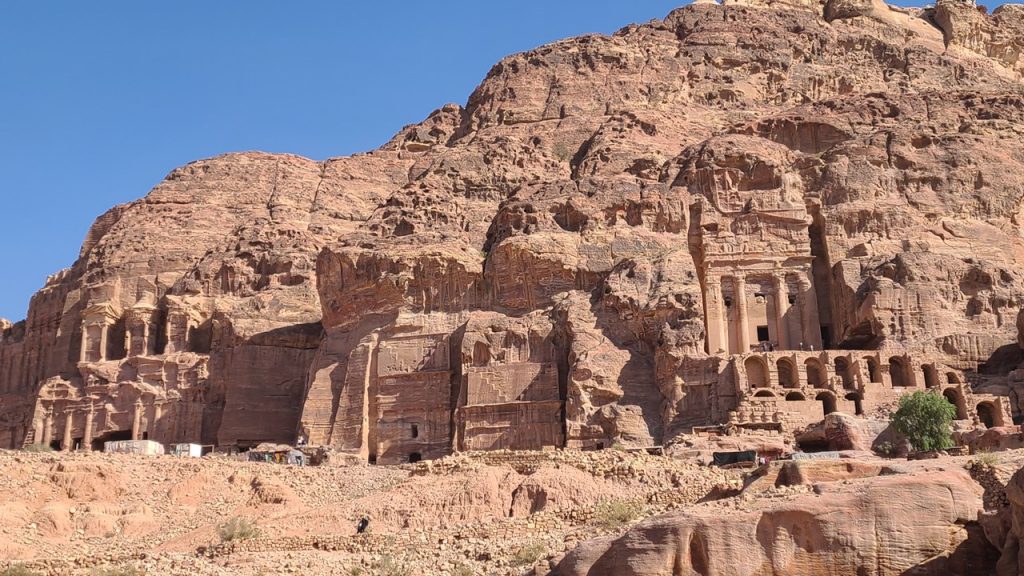
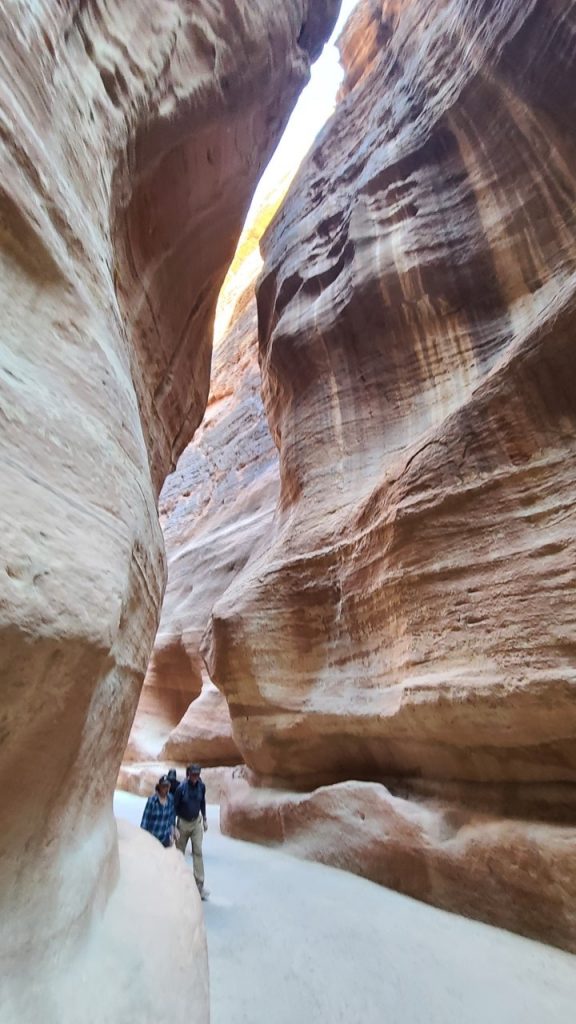
Aqaba
We headed down to sea level on our buses and arrived in Aqaba at ~6pm. The Ports of Aqaba are shared among Jordan, Israel, and Egypt, and the ship’s entire crew lined-up to greet us. Our cabins were ready and we had a lovely veranda with a generous size cabin, king bed and sofa, with a desk and large bathroom.

It turns out that the ship is brand new and had just arrived after leaving the ship yard in China, and Stopping to pick up its entire crew in the Philippines. We would be the first passengers to ever sail on the ship: ~100 of us! We did our required Muster Drill and then met briefly with our Cruise Director, Amani, who is also from Egypt. It was then time for a dinner of roasted rack of lamb before taking time to explore the ships outer decks and inner amenities. Having our first drink at one of the ship’s 4 bars, it was clear that the ship was not fully stocked, yet, and many common alcohols and mixers were not yet available. We returned to our cabin to unpack and put away our belongings and to check if we could pick up any news on the opening matches of the 2022 World Cup taking place in nearby Qatar, when we realized that the television system on the ship was not active, yet.
Our ship, the Vantage Odyssey, was built as a sister ship to the Vantage Ocean Explorer. This class of ship is suitable for polar exploration and Vantage is building 4 more just like the first two. The ship offers breakfast, lunch, tea time, and dinner daily. Tonight, we would sail only a very short distance to the Israeli port at Aqaba and requiring a one-hour time change.
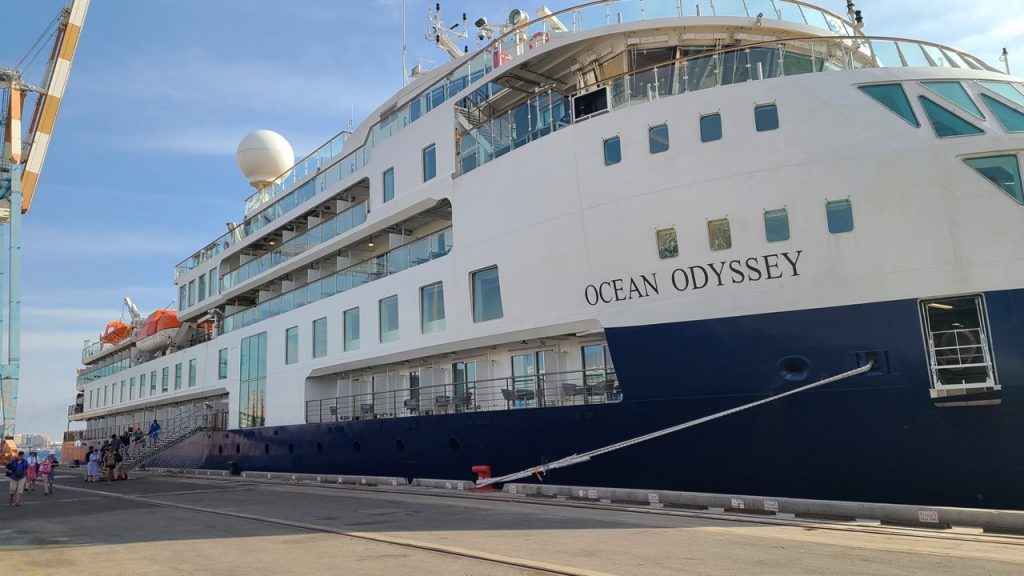
Israel
This morning, we are in the Israeli city of Eilat. We rise early to use the ships gym, but neither the treadmills not the stationary bicycles appear to have power, yet. We notify the ship’s stewards, take showers and arrive at the early breakfast for coffee, pastries and juices. Soon, we are cleared to go ashore and we choose to travel to Dolphin Reef Beach where we can swim, snorkel and visit with the wild dolphins which are trained to visit throughout the day. Our local British guide, Chrissy, takes us on a short bus ride to a small rustic beach resort where they are excited to greet us as their first major group of foreign visitors after the pandemic and provide us with free beach towels and one drink. The beach is a small pebble beach with ample chairs and shade, and an area to swim with a small reef for snorkeling; and an area for scuba and wild dolphin encounters. We snorkeled and saw parrot fish, green bump head fish, several small reef fish, mullet, Red Sea puffer fish, and live coral heads, including brain coral. We also walked out on the dock to watch the dolphins come up to us to play and splash. After a morning at the beach, we headed back to the ship for a lunch buffet and an itinerary review while the ship sets sail south into the Red Sea. That night after dinner, we watch a movie about the Valley of the Kings in Egypt where we will be heading.
